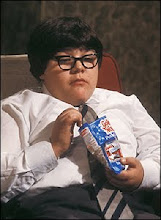
It's not a comic but, if like me, you love vintage comic book ads, then this will appeal to you. It's not a book of comic book ads either though (bear with me), Burlesque Paraphernalia is in fact a reprint of a vintage catalogue of machinery and costumes designed to be used in the initiation and hazing ceremonies of early 20th century American fraternities and secret societies.
At the turn of the last century, some 40% of American men belonged to these societies. Organisations such as The Woodmen of the World and the Benevolent and Protective Order of Elks provided a place for men to get together, fraternize and, err, play pranks on each other!
Taking their inspiration from more serious groups such as the Masons, these clubs often adopted quasi-ceremonial initiation ceremonies and, as unlikely as it sounds, an industry sprang up supplying such groups with the equipment needed to make their ceremonies as authentically weird and scary as possible.
The undisputed leaders in the invention and supply of this bizarre paraphernalia were the DeMoulin Brothers, three fairly earnest looking Victorian men with a taste for sadistic pranks and the capital required to put their Heath Robinsonesque ideas into practice.
Burlesque Paraphernalia and side degree specialities and costumes reprints The DeMoulin Brothers 1930 Catalogue. It comes with an introduction from David Copperfield, who sets the tone by recounting the time that he had a hole burnt in his arse by an antique gunpowder charged spanking paddle from the catalogue. From there we get two lengthy essays on the history of early 20th century fraternities and initiation ceremonies before catalog no. 439 is presented in all its bonkers glory.
What to say about catalog 439? It's a crazy-arse thing, full of richly illustrated intricate drawings of smartly dressed men torturing each other with ridiculous devices. There are electric carpets, exploding mallets, vats of boiling lead, spiked pathways, cages, boxing rings, spiky blocks and branding irons. All items come with gleeful descriptions of the terror which they can inspire in the minds of prospective and unwitting fraternity candidates and detailed illustrations of the gadgets in action. Here's an example of the kind of thing on offer...
De Moulin also sold the costumes for these ceremonies. Along with the devils and goats there was a selection of "Race Costumes" available, all of which are illustrated in the catalog. It's an offensive section which nonetheless provides a fascinating insight into the prevailing attitudes of the day. If looking at the racial masks leaves you with a nasty taste in the mouth, then you can always cleanse your palate by flipping back for a look at some of the mind-bendingly weird initiation gadgets.
With its electric canes and exploding cigars, the De Moulin Bros catalogue was clearly a source of inspiration to the novelty item manufacturers who plied their trade within the pages of the American comic books of the 50s, 60s and 70s. All those joy buzzers and whoopee cushions are after all just shrunken down versions of the prank machinery on display in catalog #439.
What you get with this book then is not just a fascinating glimpse into a little known corner of American social history, but the template for many of the ad pages from the silver and bronze age comics that so many of us comic collectors love. I really enjoyed it and, although it isn't about comics, I would recommend it to anyone with an interest in the history of comic book advertising.
For more London Loves Comics recommendations, click the the LLC Recommends tag below.








1 comment:
It sounds like you really enjoyed the book. If you ever have the opportunity to visit the states, plan to make a trip to the DeMoulin Museum in Greenville, IL (about 45 miles NE of St. Louis, MO). They have several of the items listed in the catalog on display as well as other products the DeMoulin Company manufactured. They are always on the look out for DeMoulin items, so if you discover any, let them know (they have a facebook page and a website). Oh, and the museum is free to visit.
Post a Comment